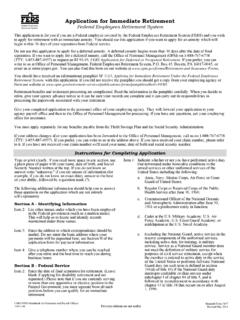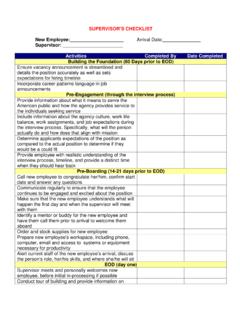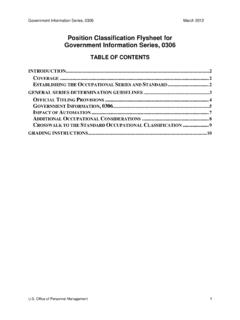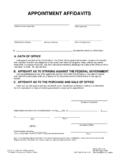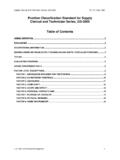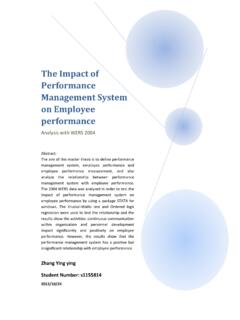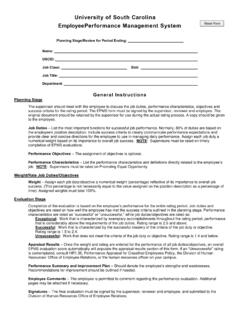Transcription of Talent Management System - OPM.gov
1 SECTION V. Talent Management System THIS PAGE INTENTIONALLY LEFT BLANK. Section V: Talent Management System SECTION V The Talent Management System Talent Management Recruitment System Retention THE Talent This section contains information specific to the Talent Management System , which focuses on agencies having Management . quality people with the appropriate competencies in mission- System critical activities. Given the interest in and the importance of the work of Government, we owe it to the American people to have hiring systems in place to ensure we have the right people on board doing the vital work of the Government.
2 OPM News Release, March 15, 2004. Definition A System that addresses competency gaps, particularly in mission-critical occupations, by implementing and maintaining programs to attract, acquire, develop, promote, and retain quality Talent . Standard The agency has closed skills, knowledge, and competency gaps/deficiencies in mission-critical occupations, and has made meaningful progress toward closing skills, knowledge, and competency gaps/deficiencies in all occupations used in the agency. Critical Success The Talent Management System is comprised of two critical Factors success factors that work together to ensure agencies have people with the right skills, in the right places, at the right times.
3 Addressing the critical success factors helps eliminate gaps and deficiencies in the skills, knowledge, and competencies of employees of mission-critical occupations in the current and future workforce. The two success factors usually work together. September 2005 Section V - 1. Section V: Talent Management System Recruitment: The workforce plan drives the aggressive and strategic recruitment of diverse and qualified candidates for the agency's workforce. Retention: Leaders, managers, and supervisors create and sustain effective working relationships with employees.
4 The workplace is characterized by: A motivated and skilled workforce Attractive and flexible working arrangements Compensation packages and other programs used to hire and retain employees who possess mission-critical skills, knowledge, and competencies. Applicable Merit The following merit System principles are especially relevant System Principles to the Talent Management System (5 2301): Recruitment should be from qualified individuals from appropriate sources in an endeavor to achieve a work force from all segments of society, and selection and advancement should be determined solely on the basis of relative ability, knowledge and skills, after fair and open competition which assures that all receive equal opportunity.
5 (5 2301(b)(1)). All employees and applicants for employment should receive fair and equitable treatment in all aspects of personnel Management without regard to political affiliation, race, color, religion, national origin, sex, marital status, age, or handicapping condition, and with proper regard for their privacy and constitutional rights. (5 2301(b)(2)). Section V - 2 September 2005. Section V: Talent Management System Required Outcome The following are required outcome metrics for the Talent Metrics Management System . Required Metric Description Purpose Organization Metric: Difference between To determine how the agency Competency Gaps Closed for competencies needed and should target its recruitment, Mission-Critical Occupations competencies possessed by retention, and development employees in mission-critical efforts to bring the occupations competencies of its workforce into alignment with the agency's current and future needs Employee Perspective Items from Annual Employee To determine the extent to Metric.
6 Questions from Survey which employees think the Annual Employee Survey organization has Talent about Organizational Capacity necessary to achieve organizational goals Employee Perspective Items from Annual Employee To determine the extent to Metric: Questions from Survey which employees are satisfied Annual Employee Survey with their jobs and various about Employee Satisfaction aspects thereof Merit System Compliance An assessment of compliance To determine decisions, Metric: Merit-Based with merit System principles policies, processes, and Execution of the Talent and related laws, rules, and practices executed under the Management System regulations governing the Talent Management System Talent Management System comply with the merit System principles and related laws, rules, and regulations September 2005 Section V - 3.
7 Section V: Talent Management System Suggested Metrics In addition to the required outcome metrics, the following metrics associated with the Talent Management System are suggested. Suggested Metric Description Purpose Turnover of Employees in Percent of turnover To track turnover of Federal Mission-Critical Occupations employees in mission-critical occupations by reason for leaving Turnover of Employees in Percent of turnover among To determine how many new Mission-Critical Occupations those serving in their Federal employees in mission- during Probationary Period probationary period critical occupations leave Federal service during their probationary period of employment and to determine whether their exit was voluntary or
8 Involuntary Time To Hire Average time from date To determine the efficiency of vacancy closes to date offer is a critical phase of the Federal extended (expressed in hiring process working days). Management Satisfaction with Management responses to To determine if hiring the Hiring Process items from Annual Employee managers believe the Survey recruitment and selection process achieves recruitment and retention goals Applicant Satisfaction with the A questionnaire published on To determine if applicants Hiring Process OPM's USAJobs Web site have a favorable impression of the recruitment and selection process Section V - 4 September 2005.
9 Section V: Talent Management System SECTION V The Talent Management System Talent Management Recruitment System Retention RESULTS: When the key elements of the critical success factor Recruitment are effectively implemented, agencies will realize RECRUITMENT. the following results: Effectiveness Results Workforce competency gaps are closed through the use of effective recruitment and retention strategies, creating a workforce capable of excellent performance in the service of the American people. Senior leaders and managers are involved in strategic recruitment and retention initiatives, which ensures the necessary organizational focus and resources are allocated to achieve recruitment and retention goals.
10 Recruitment strategies are appropriately aggressive and multi-faceted to ensure a sufficient flow of quality applicants to meet staffing needs identified in the workforce plan, positioning the agency for successful program accomplishment. Flexible compensation strategies are used as needed to attract and retain quality employees who possess mission- critical competencies. Quality of work/life programs are provided and obstacles to recruitment and retention of a quality workforce have been addressed, positioning the agency to be successful in acquiring and retaining the Talent needed for program goals and objectives.
